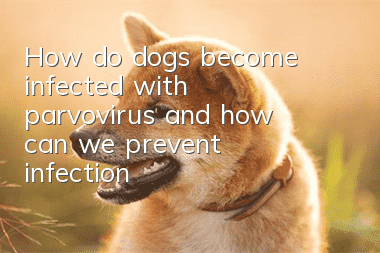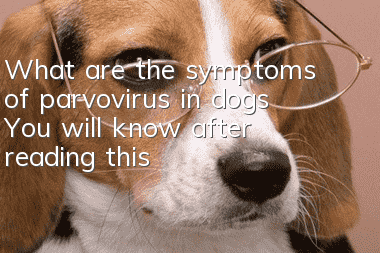How do dogs become infected with parvovirus, and how can we prevent infection?

Pet parents all hope that their pets will grow up healthily, but in life, there will always be some diseases that come quietly. Canine distemper, rabies and canine parvovirus are collectively referred to as the three warriors of the canine god of death. Pet parents must be panicking when they hear that these illnesses sound serious. Let’s take a look at how dogs are infected with these diseases, and find out the symptoms and prescribe the right medicines!
Canine parvovirus infection:
Canine parvovirus infection is a severe infectious disease discovered in recent years. Its symptoms are characterized by acute hemorrhagic enteritis and non-suppurative myocarditis. Its antigenicity is closely related to feline distemper and mink enteritis virus. The main targets of infection are canines (wolves, foxes, etc.), and all can be infected regardless of age, gender, or breed. In particular, newly weaned puppies (protected by maternal antibodies during lactation) and purebred dogs (especially German Shepherds, Rottweilers, Doberman Pinschers, and English Springer Spaniels) have the highest infection rates.
This disease can occur throughout the year, but is more common in winter and spring. Cold weather, sudden changes in temperature, high stocking density, crowding, etc. can aggravate the condition and increase mortality.
1. Enteritis type
This type of disease affects the body's absorption, and affected animals will suffer from a lack of protein and fluids, resulting in a weakened dehydrator. The mouth and eyes will become visibly red, and the heart will beat violently.
· The first stage (lasts 48 hours)
Depressed spirit
Decreased appetite
High fever (40-41℃)
Vomiting (clear/bilious/bloody)
· The second stage (lasts 6-12 hours)
Persistent diarrhea
Initial feces is gray/yellow
Then it turns bloody/contains blood clots
· The third stage (lasts 24-48 hours)
Dehydration and weight loss
Mucoid rhinorrhea
The coat is messy and the skin is inelastic
Coldness in ears, nose, and limbs
Note: If there is less blood in the stool, it indicates that the condition is mild and recovery is more likely.
2. Myocarditis type
Mild diarrhea
Physical weakness
Difficulty breathing
The pulse is sometimes fast and sometimes weak
Murmur appears on heart auscultation
Pathological changes in electrocardiogram
Note: Myocarditis type is more common in puppies aged 28-42 days. There are usually no warning symptoms and death occurs within a short period of time.
3. Mixed type (enteritis type + myocarditis type)
Symptoms of enteritis usually appear first, followed by symptoms of myocarditis. This situation is less likely, but the mortality rate is extremely high.
Most cases show that the disease is common in puppies between 6 weeks and 6 months old (receiving vaccines as early as possible can reduce the risk). The incubation period is 7-14 days. It usually occurs on the basis of environmental changes, bathing, and overeating. The hospital Test strips are usually used (you can also keep test strips at home in case of emergencies), virus isolation (urine can show liver enzymes, lymphocytes, etc.), hemagglutination and hemagglutination inhibition tests, and abdominal X-rays (showing intestinal obstruction) and abdominal ultrasound (lymph nodes) to diagnose canine parvovirus infection.
Communication channels/methods:
1. Direct contact
Healthy dogs are in direct contact with sick dogs (especially the anus); eating contaminated feed/water sources can lead to infection through the digestive tract.
Note: Asymptomatic carrier dogs can also transmit the virus.
2.Indirect contact
Touching (sniffing/licking) the excrement of sick dogs through the mouth and nose; humans who have been in contact with sick dogs (not disinfected in time/feces on the soles of shoes, etc.); external parasites, flies, cockroaches, etc. can all become virus carriers.
After infection, sick dogs will excrete the virus through their feces on the 7th to 14th day; in the acute stage of the disease, the vomit and saliva also contain the virus. Parvovirus can survive in soil for up to 1 year, and most cleaning products cannot completely disinfect it.
Treatment methods:
Like cat plague (Portal: Survive the "Seven Days of Death" and Say Goodbye to Cat Plague), there is no specific drug that can kill the virus in infected dogs, and dogs can only be supported by the outside world. water and electricity balance and nutritional needs to help them survive the dangerous period.
1. Intramuscular injection
The injection of monoclonal antibodies to the new school virus and interferon combined with symptomatic treatment measures can greatly improve the cure rate, and it has been widely used clinically.
2. Infusion
In order to help the acid-base balance, ion balance and dehydration of sick dogs, Ringer's solution (or lactate solution) can be used.Grignard solution) and 5% grape poplar in a ratio of 1:1 (1:2); for severe vomiting, add potassium; for severe diarrhea, add sodium bicarbonate. Intravenous infusion of canine albumin can accelerate the recovery of body osmotic pressure and fluid balance.
3. Control secondary infections
Antibiotics (such as penicillins, cephalosporins, fluoroquinolones, etc.) can be used according to the condition of the disease to relieve the condition. For those with vomiting, metoclopramide can be used; for severe vomiting, atropine can be used; for those with persistent bleeding, hemostasis, vitamin K, etc. can be used.
Note: The above is only a partial display of diagnosis and treatment methods. Due to different symptoms and external causes, the specific implementation plan will be decided by the doctor after diagnosis.
How to avoid infection:
· Vaccination is the most effective measure to prevent canine parvovirus. Six-unit attenuated vaccine and five-unit attenuated vaccine are often used for vaccination
· Even if the sick dog is isolated, the residence and dog utensils should be repeatedly disinfected with 10%-20% bleach solution (this is one of the few disinfectants known to be able to kill viruses)
· Dogs with weak immunity can appropriately supplement some nutrients
· It is not recommended to take puppies out of the house before they have completed their vaccinations
· Puppies should not have contact with unknown dogs for at least two weeks after completing three vaccinations
· Dogs should be cleaned up immediately after defecating outside, which can reduce environmental pollution and prevent the spread of intestinal parasites to a certain extent
Warm Tips:
· If you have raised a sick dog with parvovirus at home, wait at least one year before bringing in a new dog
· For high-risk breeds (pit bulls, Labradors, German Shepherds, Alaskan Malamutes, Doberman Pinschers, etc.), it is recommended to extend the vaccination program
· Due to the large-scale breeding/raising of unvaccinated dogs in kennels, the risk rate has increased sharply. Even if the breeder’s records show that they have been vaccinated; it is still recommended that parents take their dogs to be vaccinated again after receiving them
The predecessor of canine parvovirus infection is feline distemper (feline panleukopenia), which was first born in the 1970s. As feline distemper evolved, it began to mutate. It can not only infect cats, but can even spread the virus to canines. . The earliest case can be traced back to 1978. At that time, because there was no vaccine that could restrain this mutated virus, it caused a huge sensation and panic. And the constantly mutating canine microorganismsThe virus, so far, can still infect cats. Compared with the effective immunity time of 7 years (or a lifetime) for feline distemper, the protection time against canine parvovirus is shorter. There is no reliable research conclusion yet.
- Can adult dogs only eat one meal a day?
- How do you know if your dog has canine distemper? How to treat canine distemper!
- Tips on dog vaccinations and deworming
- How to judge whether a dog is constipated and how to improve constipation symptoms?
- Why do dogs like to bark? How to train a dog not to bark?
- How to treat canine distemper in Belgian Shepherd Dogs
- Signs of depression in dogs
- Is erythromycin eye ointment effective for dogs?
- How to use dog ear drops
- How to lose weight for golden retrievers



